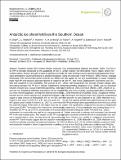| dc.contributor.author | Death, R. | |
| dc.contributor.author | Wadham, J. L. | |
| dc.contributor.author | Monteiro, Fanny Meline | |
| dc.contributor.author | Le Brocq, A. M. | |
| dc.contributor.author | Tranter, M. | |
| dc.contributor.author | Ridgwell, A. | |
| dc.contributor.author | Dutkiewicz, Stephanie | |
| dc.contributor.author | Raiswell, R. | |
| dc.date.accessioned | 2014-06-19T20:31:53Z | |
| dc.date.available | 2014-06-19T20:31:53Z | |
| dc.date.issued | 2014-05 | |
| dc.date.submitted | 2014-03 | |
| dc.identifier.issn | 1726-4189 | |
| dc.identifier.uri | http://hdl.handle.net/1721.1/88041 | |
| dc.description.abstract | Southern Ocean (SO) marine primary productivity (PP) is strongly influenced by the availability of iron in surface waters, which is thought to exert a significant control upon atmospheric CO2 concentrations on glacial/interglacial timescales. The zone bordering the Antarctic Ice Sheet exhibits high PP and seasonal plankton blooms in response to light and variations in iron availability. The sources of iron stimulating elevated SO PP are in debate. Established contributors include dust, coastal sediments/upwelling, icebergs and sea ice. Subglacial meltwater exported at the ice margin is a more recent suggestion, arising from intense iron cycling beneath the ice sheet. Icebergs and subglacial meltwater may supply a large amount of bioavailable iron to the SO, estimated in this study at 0.07–0.2 Tg yr−1. Here we apply the MIT global ocean model (Follows et al., 2007) to determine the potential impact of this level of iron export from the ice sheet upon SO PP. The export of iron from the ice sheet raises modelled SO PP by up to 40%, and provides one plausible explanation for seasonally very high in situ measurements of PP in the near-coastal zone. The impact on SO PP is greatest in coastal regions, which are also areas of high measured marine PP. These results suggest that the export of Antarctic runoff and icebergs may have an important impact on SO PP and should be included in future biogeochemical modelling. | en_US |
| dc.description.sponsorship | Leverhulme Trust (Philip Leverhulme Prize) | en_US |
| dc.description.sponsorship | Leverhulme Trust (Leverhulme Research Fellowship) | en_US |
| dc.description.sponsorship | Leverhulme Trust (PDRA grant F/00182/BY) | en_US |
| dc.description.sponsorship | Royal Society (Great Britain) (Fellowship) | en_US |
| dc.description.sponsorship | European Commission (Marie-Curie Intra-European Fellowship) | en_US |
| dc.description.sponsorship | Natural Environment Research Council (Great Britain) (NERC Fellowship NE/J019062/1) | en_US |
| dc.language.iso | en_US | |
| dc.publisher | Copernicus GmbH on behalf of the European Geosciences Union | en_US |
| dc.relation.isversionof | http://dx.doi.org/10.5194/bg-11-2635-2014 | en_US |
| dc.rights | Creative Commons Attribution | en_US |
| dc.rights.uri | http://creativecommons.org/licenses/by/3.0/ | en_US |
| dc.source | Copernicus Publications | en_US |
| dc.title | Antarctic ice sheet fertilises the Southern Ocean | en_US |
| dc.type | Article | en_US |
| dc.identifier.citation | Death, R., J. L. Wadham, F. Monteiro, A. M. Le Brocq, M. Tranter, A. Ridgwell, S. Dutkiewicz, and R. Raiswell. “Antarctic Ice Sheet Fertilises the Southern Ocean.” Biogeosciences 11, no. 10 (May 19, 2014): 2635–2643. | en_US |
| dc.contributor.department | Massachusetts Institute of Technology. Center for Global Change Science | en_US |
| dc.contributor.department | Massachusetts Institute of Technology. Department of Earth, Atmospheric, and Planetary Sciences | en_US |
| dc.contributor.mitauthor | Dutkiewicz, Stephanie | en_US |
| dc.relation.journal | Biogeosciences | en_US |
| dc.eprint.version | Final published version | en_US |
| dc.type.uri | http://purl.org/eprint/type/JournalArticle | en_US |
| eprint.status | http://purl.org/eprint/status/PeerReviewed | en_US |
| dspace.orderedauthors | Death, R.; Wadham, J. L.; Monteiro, F.; Le Brocq, A. M.; Tranter, M.; Ridgwell, A.; Dutkiewicz, S.; Raiswell, R. | en_US |
| mit.license | PUBLISHER_CC | en_US |
| mit.metadata.status | Complete | |
